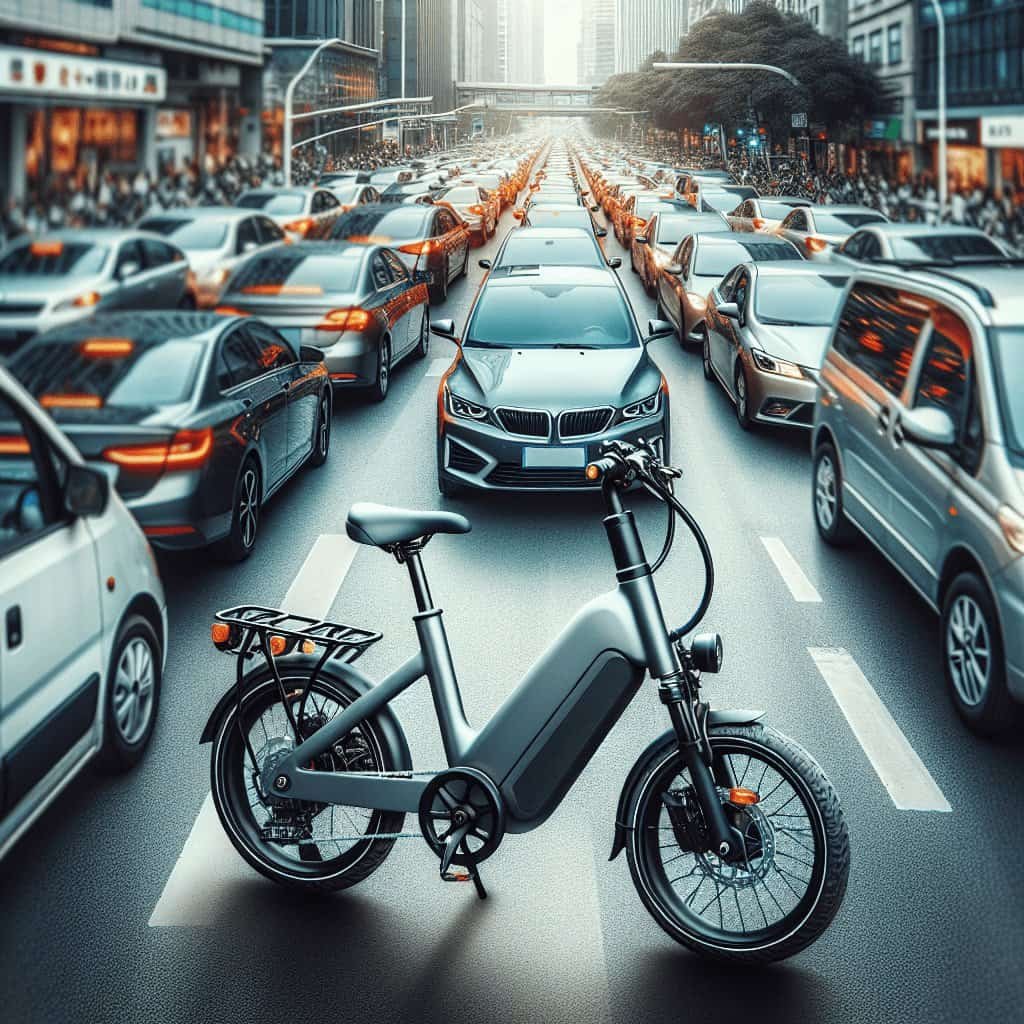Imagine cruising down the bustling streets, effortlessly weaving through traffic with a smile on your face, while also doing your part to alleviate congestion. Electric bikes have become a popular mode of transportation in recent years, raising the question of their impact on traffic congestion. In this article, we will explore how these sleek and eco-friendly vehicles have the potential to revolutionize our daily commute and reduce the infamous gridlock that plagues our cities. So hop on, and let’s ride into the world of electric bikes and their impact on traffic congestion!

Introduction
Electric bikes have been gaining significant popularity in recent years, and their impact on traffic congestion cannot be overlooked. As more people seek sustainable and efficient transportation options, electric bikes have emerged as a viable alternative to traditional bicycles and private vehicles. This article aims to explore the increasing popularity of electric bikes, the benefits they bring to traffic congestion, the challenges in integrating them with existing traffic infrastructure, case studies highlighting their impact on congestion, factors influencing their impact, public perception and attitudes towards electric bikes, government initiatives and policies to promote their use, and future prospects and potential impact.
Increasing popularity of electric bikes
Overview of electric bike market growth
The electric bike market has experienced tremendous growth in recent years. According to industry reports, the global electric bike market is projected to reach a value of $38.6 billion by 2025. This growth can be attributed to several factors, including increasing awareness of environmental issues, rising fuel costs, and advancements in technology that have led to improved battery life and performance.
Factors contributing to the rise in popularity
Several factors have contributed to the rising popularity of electric bikes. One key factor is their ability to provide a convenient and cost-effective mode of transportation. Electric bikes allow riders to travel longer distances and tackle hilly terrains without exerting excessive physical effort. Additionally, they offer a greener alternative to traditional vehicles, helping individuals reduce their carbon footprint.
Comparison of electric bikes and traditional bicycles
While both electric bikes and traditional bicycles offer a means of transportation, there are distinct differences between the two. Electric bikes provide assistance in pedaling, making them suitable for individuals who may have difficulty riding traditional bicycles due to age, health conditions, or physical fitness levels. Traditional bicycles, on the other hand, require solely human power and appeal to those seeking a more active and physically demanding mode of transportation.
Benefits of electric bikes on traffic congestion
Reduction in private vehicle usage
One of the major benefits of electric bikes is their potential to reduce private vehicle usage. By providing a viable alternative for short-distance commuting, electric bikes can help alleviate congestion on roads. Many individuals choose to use their cars even for short trips due to the convenience they offer. However, with electric bikes, individuals can opt for a more efficient and environmentally friendly mode of transportation, thereby reducing the number of cars on the road.
Improved traffic flow
Electric bikes can contribute to improved traffic flow by reducing the number of vehicles on the road during peak hours. This reduction in private vehicle usage can lead to fewer traffic jams and faster travel times. With less congestion, traffic flows more smoothly, benefiting all road users, including motorists and public transportation systems.
Less demand for parking space
A significant advantage of electric bikes is the reduced demand for parking space. Traditional vehicles require designated parking spots, adding to the challenges of urban planning and congestion. However, electric bikes can be easily parked in bike racks or designated areas, requiring significantly less space. This reduction in parking requirements can free up valuable land and contribute to more efficient use of urban areas.
Promoting active transportation
In addition to reducing congestion, electric bikes also promote active transportation. Many individuals are deterred from using traditional bicycles due to the physical exertion required, especially in hilly terrains or on longer commutes. Electric bikes provide assistance when needed, encouraging individuals to choose a more active mode of transportation without the barriers of physical limitations. This promotes healthier lifestyles and reduces reliance on sedentary modes of transportation.
Challenges in integrating electric bikes with existing traffic infrastructure
Lack of dedicated infrastructure for electric bikes
A major challenge in integrating electric bikes with existing traffic infrastructure is the lack of dedicated infrastructure tailored specifically for these vehicles. While traditional bicycles can utilize bike lanes and dedicated paths, electric bikes often fall into a regulatory gray area. This lack of dedicated infrastructure for electric bikes may deter some individuals from adopting them as a mode of transportation and lead to potential safety concerns.
Integration with public transportation systems
Integrating electric bikes with public transportation systems poses another challenge. While traditional bicycles can often be carried on buses, trains, or subways, electric bikes require additional considerations due to their larger size and potential battery hazards. Ensuring compatibility and safety between electric bikes and public transportation systems is essential for a seamless and efficient multimodal transportation experience.
Safety concerns and regulations
Safety concerns and regulations surrounding electric bikes also pose challenges in their integration with existing traffic infrastructure. These concerns include speed differentials between electric bikes and traditional bicycles, as well as the potential for accidents due to inexperienced riders or technical malfunctions. Establishing clear regulations and safety guidelines for electric bike usage is crucial to ensure the safety of riders and other road users.

Case studies on the impact of electric bikes on traffic congestion
City A: Before and after introduction of electric bike-sharing program
In City A, a study was conducted to analyze the impact of an electric bike-sharing program on traffic congestion. Before the introduction of the program, the city experienced significant traffic congestion during peak hours, particularly in the city center. After the launch of the electric bike-sharing program, there was a noticeable reduction in the number of private vehicles on the road, leading to improved traffic flow and decreased congestion in the city center.
City B: Analysis of commuting patterns after promotion of electric bikes
City B implemented a comprehensive campaign to promote electric bikes as a viable mode of transportation. The city provided subsidies for electric bike purchases and established designated bike lanes and charging stations throughout the city. An analysis of commuting patterns after the promotion revealed a shift from private vehicle usage to electric bike usage for short-distance trips. This shift resulted in reduced traffic congestion during peak hours and a more sustainable transportation network.
City C: Evaluation of reduced traffic congestion due to electric bike adoption
In City C, an evaluation was conducted to measure the impact of widespread electric bike adoption on traffic congestion. The city encouraged residents to switch from traditional vehicles to electric bikes by implementing financial incentives and developing dedicated electric bike infrastructure. The evaluation showed a significant reduction in traffic congestion, particularly during rush hours, as more individuals embraced electric bikes as their primary mode of transportation.
Factors influencing the impact of electric bikes on traffic congestion
Geographical and urban design factors
The impact of electric bikes on traffic congestion can vary depending on geographical and urban design factors. Cities with flat terrains and efficient bike infrastructure may experience a more significant reduction in congestion due to the accessibility and ease of electric bike usage. Additionally, well-designed urban areas that prioritize pedestrian and cyclist safety and accessibility contribute to a more bicycle-friendly environment, encouraging greater adoption of electric bikes and reducing congestion.
Cultural attitudes towards cycling
Cultural attitudes towards cycling play a crucial role in determining the impact of electric bikes on traffic congestion. In regions where cycling is already widely accepted and integrated into daily lifestyles, the adoption of electric bikes is likely to be more seamless. Conversely, in areas where cycling is less common or faces cultural barriers, it may be more challenging to achieve significant reductions in congestion through electric bike adoption alone.
Availability and accessibility of electric bike charging infrastructure
The availability and accessibility of electric bike charging infrastructure also influence the impact of electric bikes on congestion. Convenient and widespread charging stations can alleviate concerns about battery life and range, making electric bikes a more practical and reliable mode of transportation. Lack of charging infrastructure, on the other hand, may limit the adoption of electric bikes and hinder their potential to reduce traffic congestion.

Public perception and attitudes towards electric bikes
Positive responses and acceptance
Overall, public perception and attitudes towards electric bikes have become increasingly positive and accepting. Many individuals recognize the environmental benefits and cost savings associated with electric bikes. They appreciate the convenience and versatility that electric bikes offer, making them a viable alternative to traditional bicycles and private vehicles. Positive word-of-mouth and personal experiences have contributed to a growing acceptance of electric bikes as a legitimate mode of transportation.
Concerns and criticisms
Despite the positive responses, electric bikes still face concerns and criticisms. Some individuals express concerns about the safety implications of electric bikes, particularly regarding speed differentials and proper training for riders. Others criticize electric bikes for potential conflicts with pedestrian traffic or their perceived impact on the aesthetics of urban areas. Addressing these concerns through clear regulations, safety initiatives, and urban planning strategies can help alleviate criticisms and dispel misunderstandings.
Influence on purchasing decisions
Public perception and attitudes towards electric bikes significantly influence purchasing decisions. Positive perceptions can encourage individuals to consider electric bikes as a viable option when choosing their mode of transportation. This shift in purchasing decisions, coupled with government initiatives and financial incentives, can drive the widespread adoption of electric bikes and contribute to reducing traffic congestion in the long run.
Government initiatives and policies to promote electric bikes
Financial incentives for electric bike purchase
To promote the adoption of electric bikes, governments have implemented various financial incentives. These incentives can include subsidies or tax credits for electric bike purchases, making them more affordable and appealing to potential buyers. By reducing financial barriers, governments encourage individuals to choose electric bikes as an alternative to private vehicles, leading to a decrease in traffic congestion.
Development of electric bike infrastructure
Governments also play a significant role in developing electric bike infrastructure. This includes the development of designated bike lanes, bike-sharing programs, and charging stations. By investing in electric bike infrastructure, governments create an enabling environment for electric bike adoption and ensure the efficient integration of electric bikes with existing traffic infrastructure.
Integration of electric bikes into urban planning and transportation policies
The integration of electric bikes into urban planning and transportation policies is crucial for their successful integration into existing traffic infrastructure. Governments should consider the unique needs and requirements of electric bike users when designing roads, bike lanes, and parking areas. By incorporating electric bikes into transportation policies, governments can lay the foundation for sustainable and efficient transportation networks.

Future prospects and potential impact
Technological advancements in electric bikes
The future of electric bikes holds great promise, with continued technological advancements driving their potential impact on traffic congestion. Improvements in battery technology, range, and charging efficiency will further enhance the practicality and usability of electric bikes. Additionally, the integration of smart features, such as connectivity and navigation systems, will make electric bikes more user-friendly and appealing to a wider range of individuals.
Potential influence on transportation modes
Electric bikes have the potential to significantly influence transportation modes in the future. As more individuals adopt electric bikes, there may be a shift away from private vehicles and even public transportation for short-distance trips. This shift can reduce the overall demand for road space and alleviate traffic congestion. Additionally, the incorporation of electric bikes into integrated transportation systems, alongside buses, trains, and subways, can create a seamless and sustainable multimodal transportation experience.
Sustainability and environmental impact
The growing popularity of electric bikes aligns with broader sustainability goals and efforts to reduce carbon emissions. With electric bikes producing zero tailpipe emissions, they offer a sustainable transportation option that contributes to improving air quality and reducing reliance on fossil fuels. Incorporating electric bikes into transportation networks can help cities achieve their environmental targets and create greener and more livable urban environments.
Conclusion
The rising popularity of electric bikes presents a significant opportunity to tackle traffic congestion and promote sustainable transportation options. Through their ability to reduce private vehicle usage, improve traffic flow, and promote active transportation, electric bikes offer tangible benefits to both individuals and the environment. However, integrating electric bikes with existing traffic infrastructure poses challenges that need to be addressed through dedicated infrastructure, safety regulations, and public awareness campaigns. Government initiatives and policies play a crucial role in promoting electric bikes and creating an enabling environment for their adoption. By considering factors such as geographical and urban design, cultural attitudes, and charging infrastructure, the impact of electric bikes on traffic congestion can be maximized. With ongoing technological advancements and their potential influence on transportation modes, electric bikes have a promising future in shaping efficient and sustainable urban transportation networks.


